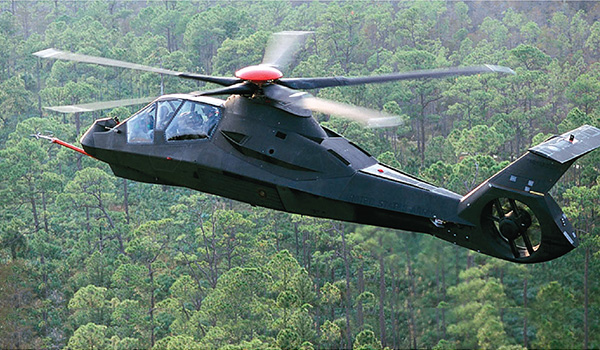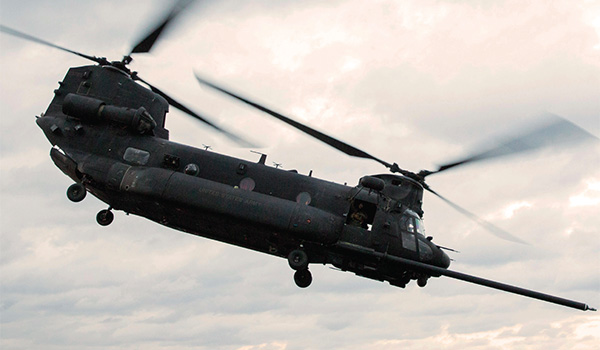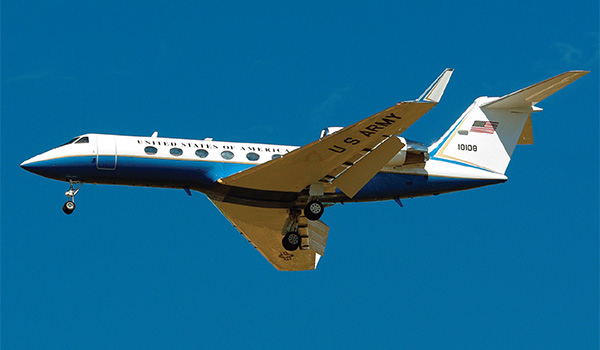
By Joseph P. Cribbins: On 6 June 1992, Army Aviation completed 50 years of dedicated service to the U.S. Army. During the fifth decade, Army Aviation matured greatly and realized a potential that had been developing since 1942. From the beginning, Army Aviation struggled for identity, first with the USAF, then in-house among the combat arms and logistics branches. There were sharp debates on whether to form a branch. Supporters believed Army Aviation needed the identity and cohesion of a combat arm like Infantry, Armor, and Artillery. Aviation had proven capable in the air maneuver dimension of battle; the Army struggled to understand how to harness this new dimension of battle.

Although selected in April 1991 by the Army, the RAH-66 Comanche program was subsequently cancelled by the Army Chief of Staffin March 2004. / BOEING-SIKORSKY PHOTO
There were concerns among others that Army Aviation would become another Army Air Corps. To prevent this, aviation should remain integrated with the combat arms and logistic branch to which it belonged.
On 12 Apri1,1983, General “Shy” Meyer, then the Army Chief of Staff, approved the Army Aviation Branch. A major feature of the new Branch was the integration of Aviation Logistics.
Today, Army Aviation has assumed a significant role in the land component’s combined arms team. Army Aviation breaks friction with the ground, operates in the ground regime, and greatly enhances the capability of the force. Reconnaissance, attack, assault, SEMA, SOF, MEDEVAC, and medium lift aviation resources are powerfully combined to give the ground commander increased agility, firepower, and versatility.
A major innovation in this decade was establishment of the PEO/PM concept. The Army has had PMs for a number of years, and the Program Executive Officer is not peculiar to aviation, but PEO now has a significant impact on selection, production, testing, and support of all new aircraft. The PEO Aviation is now responsible for an aircraft as a total weapon system from the time it is a gleam in the eye of the designer until it is completely fielded and no longer in production. This responsibility has not removed the Army Materiel Command (AMC) and appropriate Major Support Commands (MSC) from a major role in management and support of Army aircraft. The PEO and AMC/MSC work closely together as a team with a mutual goal of fielding and supporting safe, reliable, and maintainable aircraft weapon systems. The interface and work relationship between the PEO and the Aviation Systems Command – now the Aviation and Troop Support Command (ATCOM) – has been outstanding, and has given us first line Army aircraft that performed so superbly in DESERT SHIELD/STORM.
Growing Emphasis on Safety
In 1987, the U.S. Army Safety Center, located at Ft. Rucker, AL, became responsible for all safety matters across the total Army. Many significant events took place during this decade. Here are some of the major events, not necessarily in chronological order or order of importance. A major accomplishment during this decade has been the wonderful progress made in aviation safety. For example, in the late 1950s, Army Aviation was experiencing over 50 major accidents per 100,000 flying hours. During the past three years, with the exception of DESERT SHIELD/STORM, Army Aviation experienced less than two major (Category A) accidents per 100,000 flying hours. What a great accomplishment and tribute to the Safety Center, the Aviation Center, the Aviation PEO, the PMs, ATCOM, and all the members of Army Aviation and the Army who have attained this record of aviation safety.
Actions and Initiatives
As the Aviation Branch matured, a number of important initiatives were developed and actions taken. The RAH-66 Comanche helicopter, to be powered by the T-800 engine, was selected and is now in the process of testing and development preliminary to production. The selection of these two systems was unique in that reliability, maintainability, MANPRINT, and training constituted about 50% of the selection criteria – a first. Army Aviation received its first true jet aircraft, the C-20 Gulfstream and the C-21 Learjet. The Reserve Components began receiving their first line aircraft; e.g., Black Hawk and Apache. The National Guard (NG) established Eastern and Western Area Training Sites, and the four NG Transportation Aircraft Repair Activity Shops were formed into four Aviation Classification Repair Activity Depots (AVCRADs), dedicated to support of the total Army in peace and war.

The MH-47E Special Operations Chinook helicopter prototype was manufactured in 1991. / U.S. NAVY PHOTO BY MASS COMMUNICATION SPECIALIST 2ND CLASS TAMARA VAUGHN
To accurately portray what has happened in the fifth decade is not practical without revisiting Vietnam, where the helicopter proved its great worth in operations and support of the U.S. Army in combat. Some examples follow:
The Cobra was developed, tested, fielded and became the first attack helicopter. The OH-6 and OH-58 initially procured and fielded as light observation helicopters became aerial scouts. The CH-47A/B/C series Chinook and the CH-54 Tarhe provided air mobility and support. The UH-1 Huey, which was the mainstay of Army Aviation during Vietnam, did all the above in some measure, with missions of air mobility; as a gunship; command and control; observation, scout, and reconnaissance; logistics support; and medical evacuation, proving itself to be the true workhorse of the helicopter fleet. The Huey is now viewed with the same affection, respect, and regard as the C-47 Gooney Bird was during and after World War II.
Following Vietnam, the UH-60 Black Hawk was selected in the late 1970s and fielded in large numbers early in this decade. The AH-64A Apache was selected and fielded in the mid-1980s. The OH-58D-now the OH-58D Kiowa Warrior was selected as the follow-on to the OH-58A/C series, and fielding began in the late 1980s. The CH-47A/B/C Chinook was modified into the more effective CH-47D model throughout the decade. These four aircraft systems are now known as the “Big Four”. They will carry Army Aviation into the 21st century, and with the addition of the RAH-66 Comanche, they will become the “Big Five’’.

The C-20E is the military version of the Gulfstream G3. / U.S. ARMY PHOTO
The fixed wing fleet was also upgraded with the addition of C-12 pressurized airplanes. The C-12 will replace the U-8 and U-21 aircraft as well as a conglomerate of airplanes of many mission/design/series sometimes known as the Confederate Air Force. The topper in the decade was Army Aviation’s too long delayed entrance into the jet age with the advent of the C-20 Gulfstream and C-21 Lear jet. One major loss to the fixed wing fleet will be the phase out of the OV/RV-1 Mohawk, a true performer for Army Aviation for over three decades.
Concepts and Policies
By 1970, with some 4,500 aircraft (4,000 helicopters) deployed, Vietnam was also a proving ground for Army Aviation in combat. Since then, in addition to new developing and fielding aircraft systems, many initiatives have been taken in operations and support/sustainment with important concepts and policies initiated which have been improved and exercised over the years. These have made the recent successes in aviation operations and support in DESERT SHIELD/STORM possible.
Examples are:
- flying helicopters Nap of the Earth (NOE)
- using Aircraft Survivability Equipment (ASE) and maneuvers
- developing Night Vision Devices (NVD)
- nighttime operations and maintenance
- using contractor support with large numbers of contractor people devoted to aviation on the battlefield
- a dedicated air transport with Desert Express, a C-141 airlift initiated by AVSCOM and adopted by all the Services
- three level maintenance
- on condition maintenance
- weapon systems management
- Special Repair Activities (SRA-known in Vietnam as KD teams)
- integration of fighters and supporters as now witnessed in the Aviation Branch.
Some of these were not readily accepted. Army Aviation has frequently been accused of stove piping; i.e., using support systems not standard to the U.S. Army. Development of many of these initiatives was the result of having an emergency, taking appropriate action to cope with the emergency, and then when the emergency was over and the management system worked, they became a normal way of doing business. Army Aviation can take great pride in the fact that, over the years, it has been in the forefront in coming up with new ideas, developing new operational and support/sustainment systems, making them work to the overall benefit of Army Aviation; and now, to the total Army.
Emerging Threats
In November 1989, with the fall of the Berlin Wall and the rapid demise of the Soviet Union and the Warsaw Pact with which the United States had lived for 45 years, it was widely viewed that our enemies had disappeared. However, in December 1989, Army Aviation was a principal player in Operation JUST CAUSE in Panama. In August 1990, Army Aviation began deploying large numbers of aircraft to the Persian Gulf. In Southwest Asia, Army Aviation trained as a member of the combined arms team with the U.S. Army; with the joint services, i.e. the U.S. Navy, Marines, and Air Force; and with coalition forces of the United Nations. This was not a 100 hour war as portrayed by some, but truly an eight to ten month engagement in training, conducting operational and support maneuvers, and fighting and supporting a fleet of about 2,000 Army aircraft over an area nearly one-third as large as the United States in the toughest environment in which the Army has ever operated.
Other Missions
During DESERT STORM, Army Aviation became a principal player in Operation PROVIDE COMFORT, a humanitarian mission, in an equally tough environment in Southern Turkey and Northern Iraq. Humanitarian relief missions can further prove Army Aviation’s value not only to the total Army for war and contingency operations, but also to the Nation supporting national disasters where the helicopters can be such an important player. For example, during Hurricane Andrew, XVIII Airborne Corps – with its aviation supported by AMC and ATCOM – spearheaded the Army disaster relief mission.
A Great Success
Army Aviation has come a long way in five decades from the first “Cub” observation aircraft authorized in each Artillery battalion on 6 June 1942, and now recognized as the birth of Army Aviation to the “Big Four” – soon to be the “Big Five” – supplemented by a fleet of C-12 fixed wing Operational Support Aircraft (OSA) and C-20/C-21 jets. Who could have foreseen that the horse cavalry, still in existence in 1942 in the 1st Cavalry Division, would become the Air Cavalry of the late 20th century?
There have been many great success stories associated with Army Aviation over this 50 year period, The Army Aviation Branch has the potential for attractive career opportunities for all its personnel officers; warrant officers; enlisted soldiers, and civilians operational and support people alike. The high technologies embodied in aviation attract bright minds that have the spirit and will of warfighters worthy to be recognized as valuable members of the combined arms team.
As the Army considers restructuring alternatives and assumes its rightful role in national security forces, Army Aviation, with its great capability to enhance warfighting and support of the force, must be a central player in power projection – trained, ready, and capable of decisive victory for conflict in the remainder of this decade and into the next century. Moving forward with high technology, safe, reliable, and maintainable aircraft as a total weapons system and taking care of Aviation’s most valuable asset – its people – will make this happen.
Mr. Cribbins joined the Army in 1940 as an enlisted man in the 101st Cav Div. Commissioned a 2LT in1942, he was assigned to the 1st Cav Div. He served for over three decades on the Army staff as the focal point on all matters pertaining to aviation logistics, most recently as Chief, Aviation Logistics Office, ODCSLOG.








